
Chapter 10
CONVOYING AND ESCORTING OF SHIPPING
The primary advantage of a convoy system is the concentration of defense that it allows. Since it is impossible to provide an escort for every individual
ship at sea, ships must sail in groups so that each group may be adequately escorted. A secondary advantage is the reduction in number of units at sea for the
submarine to contact, since the convoy becomes the unit instead of the individual ship. It is convenient to analyze the gain achieved from convoying in the same
three steps as were discussed in the last chapter: contacts made by the enemy, his ability to make an approach, and his chance of sinking ships once firing
position is attained.
| 10.1 |
THE GAIN IN SAFETY BY CONVOYING |
| 10.1.1 |
Reduction in Number of Contacts Made by Submarines |
The institution of the convoy system results in a considerable reduction in the number of contacts made by submarines. The number of sightings made depends
on the number of units present to be sighted. Clearly, 100 independent ships sailing in a given area represent 100 opportunities for sighting, while the same
number of ships in two convoys of 50 ships each offer only two opportunities for sighting. Each sighting, however, gives 50 targets and is accordingly of increased
value, as will appear from subsequent sections. This effect tends to neutralize the benefit derived from grouping, but only to a small extent. In addition, an
increased range of detection tends to increase the number of convoys that are contacted. Although the range of detection on a 50-ship convoy is by no means 50
times that on a single ship, it is appreciably greater, and some consideration of the increase is necessary.
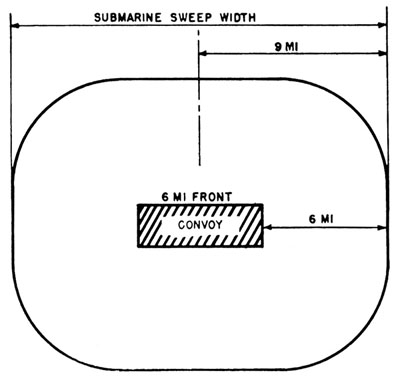 |
FIGURE 1. Submarine Sweep width on convoy. |
Visual sightings, if made on masts or superstructure, will be made at about the same range on convoys as on independent vessels. A large convoy covers a
sufficiently large area to increase the sweep rate about 50 per cent, as shown in Figure 1, but this is not a serious increase. Submarines often sight ships
by smoke, however, which may be seen at distances up to 40 miles. A single ship may make smoke only a small fraction of the time, but usually there is at least
one ship in a convoy which is smoking, and smoke becomes very much more important. If b is the fraction of time that each ship smokes, R1 the range on a ship
itself, R2 the range on the smoke, and n the number of ships in convoy, then
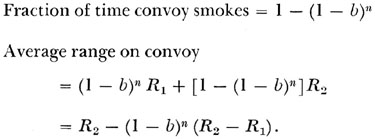 |
Equation (1) |
For convoys of as many as 50 ships, (1 - b)n is so small that the sighting range is approximately R2, the range of detecting smoke. For a plausible
set of values (R1 = 4 miles; R2 = 24 miles; b = 0.10), equation (1) gives the following average ranges.
| Single ship |
6 miles |
| 8-ship convoy |
11 miles |
| 64-ship convoy |
23 miles |
The submarine's radar will generally detect a convoy at a longer range than a single ship, because the convoy presents a larger reflecting target.
Since, however,
--100--
the intensity of the radar echo decreases very rapidly with increasing range to the target (normally as 1/r4 or faster), the increase in range is not very
great. Operational data giving ranges of submarine radar on large convoys are not available. U. S. submarines have obtained ranges about 35 per cent longer on
convoys of about 3 to 4 ships than on single ships. Aircraft radar ranges on large Atlantic convoys have been only 10 to 25 per cent greater than on single ships.
It would not be expected, therefore, that grouping of ships in convoy would cause a serious increase in the range of radar detection.
The range of sonar detection will be appreciably increased. The intensity of sound produced by a convoy of 77 ships is about n times that of a single ship. On
this basis it has been estimated that the range on a 50-ship convoy under favorable listening conditions would be about three times that on a single ship. Under
less favorable conditions the ratio would be smaller.
In order to estimate the overall change in range of detection, it is necessary to determine the relative importance of the different methods. In general,
visual detection ranks first, because of long range and ease of identification, radar second, and sonar third. During a period near the end of World War II,
for instance, United States submarines made about 800 contacts by visual detection, 300 by radar, and 50 by sonar. German U-boats have not had as effective
search radar as United States Submarines, so that the importance of radar in U-boat operations has been much less. These figures would depend a great deal on
submarine tactics: a submarine which spent most of the time submerged would make relatively more sonar contacts. It is thus evident that the contact range
increases with an increased number of ships but is by no means proportional to it. A fairly reasonable approximation would be to consider the range as
proportional to n1/3. Then the expected number of contacts made will depend on two factors: this increased range and the decrease in the number of units at
sea to be detected.
 |
Equation (2) |
where
Nc = expected number of contacts on convoys;
Ni = expected number of contacts on same ships sailing independently.
A change from n = 1 to n= 64 will reduce the number of contacts made on a given number of ships at sea by a factor of 16, according to equation (2).
This gain by convoying is somewhat enhanced by the greater ease of evasive routing of convoys. With a convoy system in operation, there are few units at
sea and it is relatively easy to direct them so as to avoid known submarines or concentrations of submarines. This would not be so practical for independent
vessels. Their number would be too great, their positions too poorly known, and their communications inadequate. Hence available intelligence concerning
submarine dispositions can be utilized most effectively with a convoy system.
The decrease in contacts resulting from a convoy system usually causes the submarines to employ "wolf-pack" tactics, in which any submarine making contact
endeavors to inform others in the vicinity and home them to the convoy. For the second and subsequent submarines, the search is no longer at random, and the
number of contacts made is increased by their additional knowledge. If half a dozen submarines can be homed to each original contact, the number of contacts
made by each is approximately six times as great as without homing. United States submarines operating in groups of about three have made about 1.7 times as
many contacts as those hunting independently.
German U-boats have formed wolf packs as large as 10 to 20 for some attacks, though their average size was, no doubt, much smaller. The general procedure
was for the first U-boat making contact to report the convoy to U-boat control (and to other U-boats) and then to trail the convoy without attacking, supplying
more information concerning the convoy as available, and, when possible, supplying homing signals to aid other U-boats in closing the convoy. On receipt of the
contact report, control would direct other U-boats in the vicinity to intercept the convoy and attack it. Thus a group of U-boats would collect in the immediate
vicinity of the convoy, each acting more or less independently. When a U-boat was in favorable position, an attack would be launched, and, after a brief
retirement, the U-boat would endeavor to get into position again for re-attack. This procedure would often be kept up for several days and nights. In this way
only a fraction of the total number of U-boats in the wolf pack would be in contact with the convoy at any one time, and only a fraction of them would be
actively attacking. Nevertheless
--101--
the ability to form a large attacking group when a convoy is sighted is of great importance in convoy battles, and much antisubmarine effort is devoted
to preventing tracking and wolf-pack formation.
| 10.1.2 |
Submarine Approach to Convoy |
When the submarine has made contact with a convoy, an approach to within torpedo-firing position must be made. There are two aspects to the submarine's
problem: the natural difficulty of making such an approach, particularly serious when submerged, and the additional difficulty of avoiding detection and
counterattack by the convoy's escorts. The typical convoy being large, slow, and unmaneuverable, the latter aspect is usually the more important. Only in
the case of a fast convoy which the submarine cannot track or overtake on the surface is there any great difficulty in the approach process when the submarine
is unopposed by escorts.
As was seen to be the case for independent ships, speed has an important effect on the safety of convoys. A speed sufficient to prevent tracking and
overtaking makes it impossible for the submarine to get into position ahead by an end run, reduces the tracking data which the submarine can obtain, and
limits it to one quick approach and attack. In addition, high convoy speed makes it difficult to gather a wolf pack for the attack. The effect of speed
cannot readily be broken down for analytical study, and presentation of operational data on the overall effect of speed is deferred until a later section.
The detailed evaluation of the effectiveness of escorts, both surface and aircraft, in detecting and preventing the approach of a submarine to a convoy, is
discussed in Volume 2B, Search and Screening, since the screening problem is simply that of searching for a target known to be trying to approach a certain
region. In Volume 2B, Chapters 8 and 9, methods are described for deciding on the optimum screening disposition or plan. Consequently, the problem of making
such decisions will not be discussed here. The general method of analysis, however, is as follows.
The convoy is surrounded by a torpedo danger zone which includes all points from which the submarine has a fair chance of hitting one or more ships in the
convoy (a chance of 25 per cent or greater, for example). Ahead of this zone is another called the submerged approach zone, bounded by the limiting approach
lines on the sides and the submarine's detection radius of the convoy on the front. Any submarine in this zone is considered to be aware of the presence of
the convoy and can approach it submerged. To the flanks and rear is the surfaced approach and tracking zone, in which submarines are in contact with the
convoy but must remain on the surface to have sufficient speed to approach or track it. (For a fast convoy this zone also has a limiting after-bearing behind
which the submarine cannot approach, even on the surface.) These zones are shown in Figure 2.
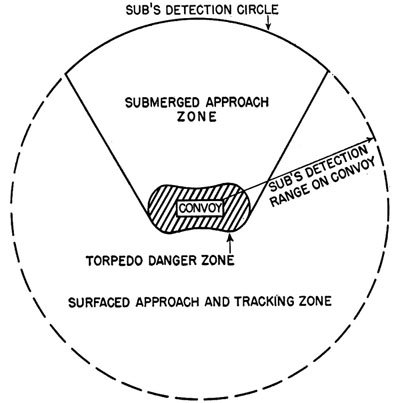 |
FIGURE 2. Submarine approach zones around a convoy. |
The primary aims of aircraft escort are two.
- To force down submarines in the surfaced approach and tracking zone and cause them to lose contact with the convoy; and
- To detect submarines which would enter the submerged approach zone and prevent them from doing so. The submarines are to be forced down and
immobilized so that the convoy may be turned away from the contact and thus avoid the submarine.
A good aircraft escort plan should reduce by at least 50 per cent the number of submarines gaining access to the submerged approach or torpedo
danger zones. In addition, tracking and wolf-pack formation are made very much more difficult.
The chief aim of the surface craft screen is to detect submarines in the submerged approach zone and take them under counterattack before they can fire
--102--
torpedoes. In addition, surface craft may take offensive action against submarines first contacted by aircraft and must be prepared to intercept
surfaced approach and prevent tracking when air cover is not available. Their effectiveness in the latter role is difficult to estimate. With a normal
size convoy, sonar screens may reasonably be expected to intercept 50 to 75 per cent of the approaching submarines, assuming good sonar conditions and a
normal number of screening ships.
To compare the safety of a convoy with that of an independent ship on a theoretical basis, all these factors should be taken into account quantitatively.
This can be done only in the most approximate sort of way. The aircraft screen should intercept at least 50 per cent of the submarines approaching, and the
surface craft at least 50 per cent of those not detected by aircraft. Other things being equal, the submarine would be able to carry through less than
one-quarter as many approaches to escorted convoys as to independent ships per hundred initial contacts. The danger of attacking an escorted convoy is
great enough to have an important psychological effect, as well. A strong escort may deter the submarine commander from even trying to attack. Actually,
the large size and low maneuverability of a convoy certainly simplify the submarine's approach problem somewhat, and it seems probable that the ratio between
the fraction of successful approaches on convoys and the fraction on independents would be nearer one-half than one-quarter.
| 10.1.3 |
Torpedo Hits Slightly Easier to Achieve on Convoys |
Having achieved a firing position, the submarine still has the problem of securing one or more torpedo hits. It is evident that this will be easier
with a convoy than with an independent ship, since a large number of targets is presented. In general, the submarine will fire at a particular ship, but
may fail to hit it and hit some other ship instead. A detailed discussion of the calculation of the probability of such hits is discussed in connection
with the mathematical formulation of the screening problem in Volume 2B, Chapter 8. A typical example will suffice to illustrate the principles involved.
Consider the case of a submarine firing into a large convoy from abeam as shown in Figure 3.
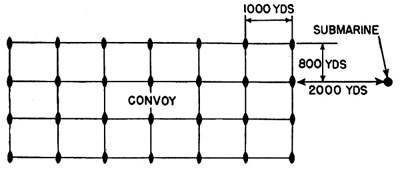 |
FIGURE 3. Typical convoy disposition. |
A torpedo fired from 2000 yd abeam can pass through several columns. If it is fired at random, its probability of encountering a ship while passing through
the first column would be 1/800 where l is the length of a ship in yards. For l = 140 yd, the chance of a hit in passing through three columns (5000-yd range
torpedo) would be
 |
Equation (3) |
If a total of four torpedoes is fired, the expected number of hits is 4 x 0.44 = 1.76. Since not all hits will cause ships to sink, it is reasonable to
estimate that 1 to 12 ships would be sunk as a result of the attack10.
This is to be compared with a maximum of one ship in an attack on an independent ship;
an average result would probably lie in the range from ½ to 1 ship sunk per attack on an independent. On this basis we would expect the ratio between
sinkings per salvo fired at a convoy and sinkings per salvo fired at an independent to be not greater than three to one, and, more likely, about two to one.
It is evident from Figure 3 that the number of ships sunk per salvo will not depend at all critically on the size of convoy. If the submarine uses a
torpedo of 5000-yd range, it can penetrate only about three or four columns, so that increase in convoy size to more than four columns causes no further
increase in ships sunk per salvo. Only with very long-range torpedoes does this quantity continue to increase after a convoy size of 10 to 20 ships has
been reached.11
--103--
TABLE 1. Convoy losses in North Atlantic, August 1942 - January 1943.
| |
Convoys |
Ships |
Convoys
sighted
by U-boat |
Ships sunk |
Per cent
convoys
sighted |
Per cent
ships
sunk |
| HX (eastbound 9½ kt) |
23 |
923 |
8 |
12 |
35 |
1.3 |
| SC (eastbound 7 kt) |
24 |
991 |
14 |
45 |
58 |
4.6 |
| ON (westbound 9½ kt) |
24 |
897 |
11 |
29 |
46 |
3.2 |
| ONS (westbound 7 kt) |
23 |
836 |
11 |
31 |
48 |
3.7 |
| 10.1.4 |
Overall Value of Convoying |
From these figures a very rough estimate of the overall gain of safety by convoying can be made. A typical average size of convoy during the Battle
of the Atlantic was about 30 ships. Transatlantic convoys were often larger, coastal convoys normally smaller. For the comparison three factors must be
taken into account.
- The ratio of contacts made on convoys to those on independent ships for the same number of ships at sea, which according to equation (2) is given by
(30)-2/3, or about one-tenth.
- The relative difficulty of making the approach to firing position. It was estimated that the submarine would be successful about half as often with convoys.
- The fact that sinkings per chance to fire a salvo are probably about twice as great with large convoys.
The net effect of these factors is:
 |
Equation (4) |
This is a considerable gain in safety and is in reasonable agreement with the observed difference in loss rate given in Part I. The loss per month in
convoy was 4 per cent during early 1942 in the United States Strategic Area, while that for independent ships was 20 per cent, a ratio of one to five.
This ratio is somewhat less than that estimated in equation (4), which is surprising because equation (4) should give a fairly conservative estimate of
the gain involved in convoying. One possible explanation of the discrepancy is the emphasis placed by the Germans on wolf packs, by which the advantages
of convoying can be largely neutralized. If a pack of ten submarines were collected on each contact and all were effective, the loss in convoy, based on
equation (4) would be the same as for independent ships, rather than one-tenth as great. Thus the operational ratio of one-fifth might be interpreted as
implying that the Germans were able to home an extra U-boat to each contact, on the average. In many cases, wolf packs of more than two U-boats were formed,
but in many other cases only one U-boat was in contact. The average number of U-boats attacking each contact would be two, which can be compared with the
number 1.7 which United States submarines have achieved while operating in groups (of about three).12
It may be concluded that there is no irreconcilable difference between our theoretical estimate of the situation and operational data for the period
quoted, which data are typical of operational results. This overall agreement confirms the belief that convoying is probably the most effective method of
reducing sinkings but does not prove that the foregoing picture of the mechanism by which sinkings are reduced is correct. In order to throw further light
on the details of the process, it is necessary to analyze the operational data more carefully and determine the effect of factors such as size and speed of
convoy and strength of escort, on the losses of ships from convoy. A number of such studies are discussed in the following section and are correlated with
the rough theory given above.
| 10.2 |
OPERATIONAL STUDIES OF THE EFFECT OF VARIOUS FACTORS ON THE SAFETY OF SHIPS IN CONVOY |
| 10.2.1 |
The Effect of Convoy Speed |
Speed has a very considerable effect on the safety of independent ships and might therefore be presumed to have a similar effect for convoys. There
--104--
have been, however, relatively few convoys of speeds from 10 to 20 knots, in which speed range the outstanding effects are observed with independents.
In order to have for study a large number of convoys with serious exposure to submarines, it is necessary to deal with North Atlantic convoys, whose
maximum speed was about 9½ knots. Data on these convoys for the 6-month period from August 1942 through January 1943 are presented in Table 1. During
this period 80 to 110 U-boats were operating in the North Atlantic and convoy losses were high.
From Table 1 it can be concluded that (1) the effect of speed in the success of the attacks is quite clear in eastbound and unclear in westbound convoys,
and (2) that an effect of speed on sightings may be present but is not strongly indicated. The discrepancy between eastbound and westbound convoys is very
striking and makes interpretation of the data difficult.
In an attempt to explain this difference, the routes of a fair sample of convoys (omitting those for ON convoys which traveled very much to the south
because of containing a portion bound for Africa) were reconstructed. The mean eastbound and westbound tracks are given in Figure 4. The westbound convoys
evidently have traversed a route some 200 to 400 miles south of the mean eastbound route between 20°W and 50° W.
A plausible explanation of the different effects of speed on eastbound and westbound convoys follows: Eastbound convoys being farther north received better
air cover since aircraft flew from Iceland. Consequently U-boats operating against them had to spend a larger fraction of their time submerged. The mean speed
of U-boats is therefore less when attacking eastbound than westbound convoys. Consequently the increase of speed from 7 to 91/2 knots may be a critical range
and give large loss reduction for eastbound convoys, though not for westbound. This line of reasoning is confirmed by the fact that aircraft made 40 attacks
on U-boats in connection with eastbound convoys and only 5 with westbound.
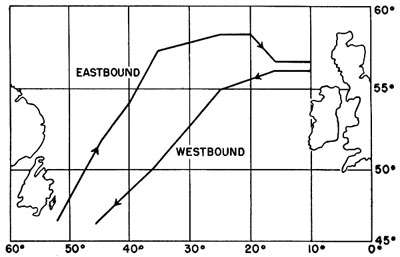 |
FIGURE 4. Average convoy routes in the North Atlantic, August 1942 through January 1943. |
What is really needed to make the effect of speed quite clear is a set of transatlantic convoys all of which have received approximately the same air cover.
Those convoys which travel a southerly route in general are not covered, and, as was shown in Figure 4, this has applied more to westbound than to eastbound
convoys. If we eliminate all convoys which make the mid-ocean part of the voyage south of the Great Circle route, the remaining ones should be fairly homogeneous
with respect to air cover and should give an indication of the value of speed under those conditions. For this purpose the routes of all transatlantic convoys
from October 1942 to early May 1943 were plotted out and those which spent more than half their time (between 15° W and 45° W) south of the Great Circle
route eliminated.13 The remainder is shown in Table 2. Stragglers are included in the figures.
TABLE 2. Losses for convoys on northerly routes.
| |
Number
of
convoys |
Per cent
sighted |
Per cent
attacked |
Ships
sunk per
convoy
sailing |
| SC and ONS (7 kt) |
36 |
68 |
43 |
1.9 |
| HX and ONF (9½ kt) |
44 |
68 |
41 |
1.3 |
--105--
TABLE 3. Losses for various sizes of convoys, 1941-1942
(North Atlantic Allied convoys - wolf-pack attacks).
Size of
convoy |
Number of
pack attacks |
Average
number of
ships |
Average
number of
escorts |
Average
size of
U-boat pack |
Average
number of
ships sunk
per attack |
Ships sunk
per U-boat
attacking |
| 0-14 |
1 |
11 |
4.0 |
4.0 |
7.0 |
1.8 |
| 15-24 |
8 |
20.4 |
6.5 |
6.5 |
4.8 |
0.7 |
| 25-34 |
11 |
29.7 |
6.8 |
5.1 |
5.6 |
1.1 |
| 35-44 |
13 |
38.5 |
6.1 |
5.8 |
6.1 |
1.1 |
| 45-54 |
7 |
78.3 |
6.5 |
5.2 |
4.9 |
0.9 |
| 55 and over |
2 |
62.5 |
8.0 |
7.5 |
9.0 |
1.2 |
The number of convoys is large enough that the data may be considered significant. There is no difference in the frequency of sightings or attacks,
but the number of ships sunk per fast convoy is two-thirds of that per slow convoy.
The overall conclusion is that some curve similar to that of Figure 3 in Chapter 9 obtains for convoys, but it is probably displaced in the direction
of lower speeds. Air cover tends to cause the critical region of the curve to occur at slower speeds, and the shape of the curve depends on the extent of
aircraft escort. The data available are very far from adequate to establish the detailed nature of this curve and its dependence on the air escort provided.
| 10.2.2 |
The Effect of Convoy Size |
It might very reasonably be claimed that the effect of convoy size is the most important phenomenon associated with convoying; it is, in fact, the essence
of convoying, since an independent vessel can be considered to be a convoy of one ship. On the other hand, the presence of escorts might be considered the most
important feature of the convoy system, and this feature will be discussed immediately after consideration of the effect of convoy size.
Several studies have been made of the losses suffered by North Atlantic convoys as a function of size and, although the losses were fortunately too small to
provide data of unquestionable statistical significance, they lead to some very interesting conclusions. In the first place, data are presented in
Table 3 pertaining to convoys which were attacked during 1941-1942 and in which the approximate number of attacking U-boats was known.
The striking feature of Table 3 is the constancy of the figures in the last column. There is certainly no clear tendency for the number
of ships sunk to increase with size of convoy. It might be expected that there would be a natural tendency in that direction which would be counterbalanced by
an increased strength of escort with the large convoys, but the figures given do not bear out such a contention. For convoys of from 15 to 55 ships the strength
of escort was virtually constant, but no appreciable change of sinkings with size of convoy is observed. Hence the earlier theoretical conclusion that increase
in convoy size to more than four columns causes no further increase in ships sunk per salvo is borne out by the operational data. A convoy of 15 or more ships
is apparently large enough that the number of ships sunk per U-boat attack does not depend on convoy size. Such would not be the case for smaller convoys,
where we would expect increased size to be associated with an increase in number (though not in fraction) of ships sunk. Data on small convoys are available
from attacks by United States submarines on Japanese convoys. For the period from July 1, 1942 to March 1, 1943, the results are given in Table 4.
TABLE 4. Sinkings from Japanese convoys as a function of size.
| Size of convoy |
Total number
of convoys |
No. of M/V
sunk |
M/V sunk
per convoy |
| 1 |
1222 |
276 |
0.23 |
| 2 |
400 |
142 |
0.36 |
| 3 |
243 |
103 |
0.42 |
| 4 |
174 |
79 |
0.45 |
| 5 |
98 |
70 |
0.71 |
| 6 |
74 |
47 |
0.64 |
| 7 |
33 |
28 |
0.87 |
| 8 |
27 |
16 |
0.60 |
| 9 |
14 |
13 |
0.93 |
| 10 |
15 |
16 |
1.07 |
| 11-12 |
23 |
16 |
0.70 |
| 13-14 |
12 |
19 |
1.60 |
| 15-20 |
7 |
8 |
1.10 |
--106--
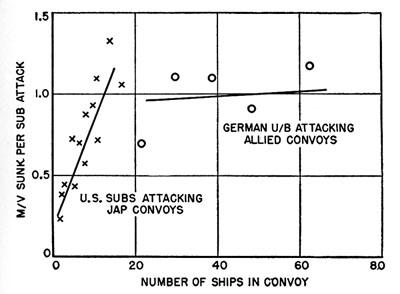 |
FIGURE 5. Effect of convoy size on ships sunk per submarine attack. |
With smaller convoys, there is a definite increase in the number of merchant vessels sunk as the size of convoy increases, which is in accordance with
expectations. A comparison of the two sets of data is presented in Figure 5. The two are not directly comparable, since the sizes of convoys involved do not
overlap and since the effectiveness of escort in the two cases is undoubtedly different. Nevertheless, the overall picture of a considerable increase for small
convoys followed by an inappreciable increase for sizes above 20 ships is quite clear.
So far attention has been devoted to the ships sunk per submarine attack, omitting the frequency with which the attacks occurred. From the data presented it
appears that large convoys are much the safest for the individual ships, since the fraction of convoyed ships sunk decreases markedly with increasing convoy size.
If, however, it were much easier for a submarine to make an attack on a large convoy than on a small one, by virtue of the greater ease of contact and approach,
there would not necessarily be any overall gain in the adoption of large convoys. In order to determine whether the preceding results give a true picture of the net
effect of changes in convoy size, the problem must be studied in more general terms.
This was done by selecting a fixed region (the United States Strategic Area east of 50° W) in which the U-boat activity was high and by determining the
losses suffered by transatlantic convoys in crossing this area as a function of convoy size. A total of 114 convoys were studied; they spent an average of about
7 days in the area. The period covered is from July 1, 1942, to March 31, 1943. A total of 160 ships were sunk. The pertinent data are summarized in Table 5.
TABLE 5. Frequency of attacks and sinkings as a function of convoy size.
(1942-1943, Western North Atlantic)
Number of
merchant
vessels |
Average
number of
attack-days*
per convoy |
Average
number of
sinkings**
per
attack-day |
Average
number of
sinkings
per convoy |
Average
number of
escorts
per convoy |
| 10-29 |
0.5 |
1.9 |
0.9 |
6.5 |
| 30-49 |
0.4 |
2.7 |
1.0 |
6.4 |
| 50-69 |
0.5 |
2.3 |
1.0 |
6.8 |
| * |
An attack-day is defined as a day on which a sinking occurred. |
| ** |
Sinkings in convoy only; stragglers are excluded. |
Again the losses suffered by the convoys do not depend on size of convoy. On the average, approximately one ship was sunk from each convoy crossing the
region, regardless of its size. Since the convoys in the 50 to 69 group were about three times as large as those in the 10 to 29 group, each ship in the
large convoys was exposed to only about one-third the danger to which each was exposed in the smaller ones.
| 10.2.3 |
The Value of Surface Escorts |
An outstanding feature of the convoy system is the provision of protective forces, both surface craft and aircraft. Surface craft will be discussed first.
These antisubmarine ships have a number of functions:
- detection of submerged submarines at the front of the convoy and of surfaced submarines approaching from any bearing
- offensive sweeps to harass, locate, and put down submarines in the vicinity which are trying to trail the convoy or get into position ahead of it
- attacks on submarines when opportunity presents
Escort of convoy is more than a matter of defensive screening, and the most successful escort group has been the one which prevents the enemy from ever obtaining
the initiative and launching a determined attack on the convoy. The conflict between the group of escorts and an attacking wolf pack is one which cannot be simply
described but involves the skillful use of radar, sonar, visual detection, radio direction finding, available intelligence, and weather conditions, and an avoidance
of routine and stereotyped tactics. An endeavor to estimate the value of escorts on a theoretical basis
--107--
would be a hopeless task, but an interesting indication of their importance can be obtained from operational data.
Numbers corresponding to those of Table 3 are given in Table 6 for 1941-1942 in the North Atlantic.
TABLE 6. Merchant ship losses as a function of escort strength.
(1941-1942 in North Atlantic).
Escort
strength |
Number of
pack attacks |
Mean escort
strength |
Ships sunk per
U-boat in pack |
| 1-4 |
22 |
3.4 |
0.88 |
| 5-9 |
51 |
6.7 |
0.75 |
| 10-15 |
75 |
11.1 |
0.34 |
The final column gives the average number of ships sunk in an attack per U-boat present in the attacking wolf pack. This figure is a measure of U-boat
success in penetrating the screen and sinking ships. The chief effect of surface escorts might be expected to be in preventing the U-boat from reaching
firing position. In very simple terms we can interpret the figures (plotted in Figure 6) in the following way.
1. Assume that in the absence of any escorts the U-boat can make a virtually unopposed approach and sink 1.2 ships. (Earlier it was estimated that a salvo
would sink 1 to 1.5 ships.) When escorts are present, their effect is considered to be one of reducing the fraction of cases in which the submarine reaches
firing position undetected, but the number of ships sunk if it does so is not changed.
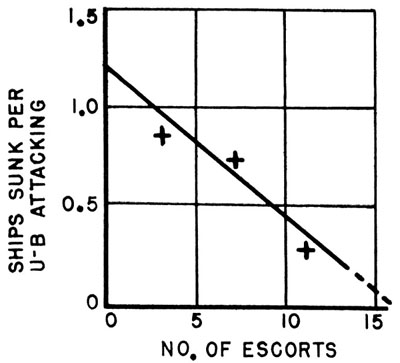 |
FIGURE 6. Effect of number of escorts on convoy losses. |
2. The effect of each additional escort is to reduce the ships sunk by about 0.075 ship, that is, to reduce the U-boat's chance of penetrating the screen
by about 6 per cent. Apparently, 16 escorts would give complete protection. During the period under study most attacks were made at night and the sort of
perimeter which the escorts had to defend is shown in Figure 7. If 16 escorts are distributed around this perimeter, it can be seen that each one effectively
screened about 2 miles of it or, in other words, had an effective detection range of about 1 mile on the U-boats under those conditions (surfaced night attacks
predominating; most ships fitted with radar, but not all centimeter type; North Atlantic wolf pack operations).
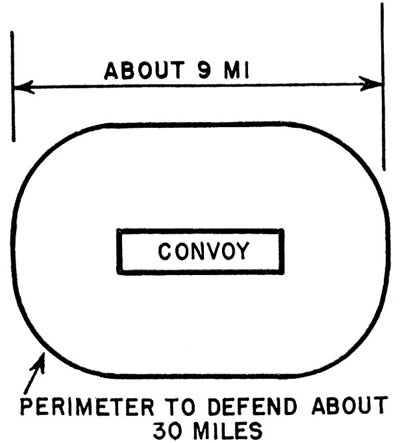 |
FIGURE 7. Zone to be defended by escorts. |
It is rather surprising that there is no evidence of an upward concavity in the curve of Figure 6. It does not seem likely that even 16 or more escorts
could completely prevent submarines from sinking any ships, but it does seem likely that the number of ships sunk would be made very small, perhaps 0.1 or 0.2,
for large numbers of escorts. On the other hand, it may be that the presence of a large number of escorts is sufficient to discourage U-boats from aggressively
pressing home attacks. Perhaps they would consider it too dangerous to attack a convoy with 15 or more escorts ever to try to do so, even though they might
actually have some chance of success. The data available are sufficient only to suggest this question, not to answer it. They do, however, show conclusively
that strength of escort played a very important role in determining ship losses.14
The figures of Table 6 are given on a per attack
--108--
basis, however, and do not take into account the frequency of attacks. Since surface escorts are often used for offensive sweeps designed to shake off
trailing U-boats and prevent attack, such figures may not be a complete measure of the escort's value. Unfortunately, it is not possible to determine from
operational data the ability of the escorts to prevent attack. One complicating feature is the tendency to provide more escorts when and where the danger is
greatest, which increases the relative number of attacks made on convoys when many escorts were present. Actually the data of Figure 6 may be considered a
conservative indication of the value of surface escorts.
| 10.2.4 |
The Value of Aircraft Escorts |
Similar information on the value of aircraft can be obtained by comparing the losses suffered by aircraft-escorted convoys with those sustained by convoys
without such escort. Data are presented in Table 7 for North Atlantic convoys from August to December 1942. Only the days (and nights following) on which U-boats
were known to be in contact are included, so that all figures pertain to threatened convoys.
TABLE 7. Ship losses as a function of air escort.
(August to December 1942, North Atlantic).
| |
Number
of days |
Ships
torpedoed |
Average number
of sorties |
Average size
of U-boat
pack in contact |
Ships
torpedoed
per day |
| With air cover |
38 |
23 |
4 |
4.9 |
0.60 |
| Without air cover |
43 |
75 |
0 |
5.5 |
1.75 |
Since the days with and without air escort pertain to the same convoys and are in the same period, with approximately the same size of wolf pack in contact,
we can feel quite confident that the difference between 0.60 and 1.75 ships torpedoed per day is actually due to the aircraft escort. The number of ships torpedoed
is reduced to about 30 per cent of the value that it would otherwise have by the presence of such escort (an average of four sorties per day staying about 2 hours
with the convoy). This figure, of course, applies to convoys encountering wolf packs of surfaced U-boats and must be used with caution. In addition, there is an
interrelation between convoy speed and the effect of aircraft escort which was previously noticed in connection with analysis of speed effects. Figure 8 is an
effort to present the probable form of the relationships.
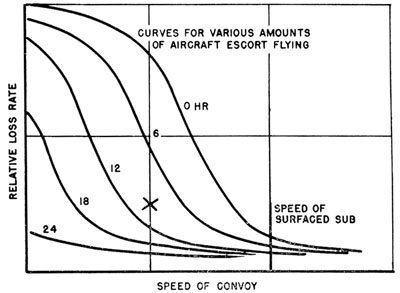 |
FIGURE 8. Effect of aircraft flying and convoy speed. |
The curves are drawn for various amounts of aircraft escort flying. The general belief is that the primary effect of aircraft flying is to reduce the speed
of convoy for which the submarine can carry out Method B tracking and approach, because it is forced to submerge at least part of the time. If we assume that 24
hours per day aircraft flying will eliminate tracking even for the slowest of convoys, then the curves drawn may be taken as representing 0, 6, 12, 18, and 24 hr
of aircraft flying per day. The plotted X corresponds to the data of Table 7 (average speed of convoy about one-half surfaced U-boat speed, loss rate reduced
to 30 per cent). Since the point is for 8 hr per day of flying and lies suitably enough between the 6-hr and 12-hr curves, the operational data can be considered
in agreement with the curves which were sketched in on the basis of very qualitative arguments. It may be concluded that the curves of Figure 8 give a good
indication of the effect of aircraft escort and convoy speed on the losses of ships from convoys, but data available are not sufficient to demonstrate their
exact nature, and they can be based only on indirect and devious reasoning.
| 10.3 |
THE IMPORTANCE OF LARGE CONVOYS |
It is evident from the preceding discussion that ships are safest when sailing in large, well-protected convoys. Although this fact may seem trivially
obvious, a quantitative estimation of the overall importance of large convoy size is of interest.
--109--
For purposes of comparison, consider a situation in which a total of ten ships and one escort are ready to sail each day and calculate the losses for
three cases: 30-ship convoys, 60-ship convoys, and 90-ship convoys. A convoy spends 6 days in the dangerous region, and a total of 12 hours per day of flying
can be done actually escorting convoys. Convoy speeds are assumed to be one-half the submarine's surfaced speed. The tactical situation is presented in Table 8.
TABLE 8. Comparison of convoy sizes.
| |
Case |
| I |
II |
III |
| No. of ships in convoy |
30 |
60 |
90 |
| No. of escorts with convoy |
3 |
6 |
9 |
| Days between convoys |
3 |
6 |
9 |
| Convoys in danger areas |
2 |
1 |
2/3 |
| Flying hours per convoy day |
6 |
12 |
18 |
Correspondingly, a table can be made of the contributions to relative loss rate of each of the factors involved: convoy size, number of escorts, and extent
of aircraft flying. This is done in Table 9.
TABLE 9. Relative loss rates.
| |
Case |
| I |
II |
III |
| Effect of convoy size [Fig. 5 and eq. (2)] |
1.00 |
0.69 |
0.56 |
| Effect of number of escorts (Fig. 6) |
1.00 |
0.75 |
0.55 |
| Effect of aircraft flying (Fig. 8) |
1.00 |
0.50 |
0.30 |
| Overall |
1.00 |
0.26 |
0.09 |
Thus it may be concluded that ships in large convoys are very much safer than those in small or medium-sized ones under the conditions of this example. A
ship's chance of being sunk in a 90-ship convoy is about one-tenth that in a 30-ship convoy. In order to achieve full effectiveness from convoying as a means
of protecting ships, it is of utmost importance to make the convoys large and well-defended. There are certain practical limitations to the size of convoy that
can be sailed, but these results show that for maximum safety of ships convoys should be made as large as possible, larger, in fact, than they normally have been,
even in the Atlantic.
The chief difficulties involved in very large convoys are:
- Increased difficulty of communications within the convoy. Signals from the commodore's ship must be passed from one ship to another along rows and columns, and
the passing of visual signals by merchant ships in a large convoy leaves much to be desired. Ships in convoy maintain radio silence, and a secure system of
intra-convoy signaling has never been available. It is possible that the maintenance of radio silence may not be justified when the losses through faulty
communication are balanced against the gains due to evasion of U-boats.
- Decreased maneuverability of convoy. With large convoys turns are difficult in any case and the ease of maneuvering is not a critical function of size.
- Increased number of stragglers. It may be argued that a greater fraction of ships will straggle from large convoys, primarily because of (1) and (2) above,
and, since danger to stragglers is high, this may seriously increase the losses suffered by large convoys. Operational data, however, indicate that this effect
is not large, probably because the chief reasons for straggling are engine breakdown or similar failures which are in no way related to size.
- Increased port congestion. To some extent any convoy system crowds harbor facilities, but the difficulty is increased the larger the convoys are. To the
extent that ships spend unnecessary days in port, they are not available for carrying cargo and their value is reduced. The turn-around time in port is made up of:
- Waiting for berths to load and discharge. (This applies mainly to ships handling dry cargo, not to tankers.)
- Discharging and loading.
- Waiting in the channel for a convoy to sail.
Period (a) will usually be kept fairly small after the convoy system has operated for a time but may be extended if the size of the convoy is increased
above what has been a working average. Period (b) depends on the nature of the cargo and varies between 2 and 20 days, as a rule. Period (c) averages half
the time between convoys ("convoy cycle"). Hence, an increase in convoy size will somewhat increase the turn-around time.
The ultimate limitation on convoy size is thus the effect of increased size on the time spent in port and consequent slowing down of the actual transport
of goods. If, for example, the average ship spends 10
--110--
days at sea and 15 days in port for an average convoy size of 30 ships, but 20 days in port for a convoy size of 90 ships, the increase in convoy size
reduces the rate of cargo transport by 20 per cent. This is equivalent, as far as cargo carrying capacity goes, to an immediate sinking of 20 per cent of
the ships involved and cannot be tolerated except in cases where the expected number of ships saved by the increase in convoy size is comparably great.
| 10.4 |
LIMITATIONS ON CONVOYING |
It has been shown that a convoy system greatly increases the safety of ships at sea, especially if convoys are large and well protected. The gain is
accompanied, however, by a loss in cargo carrying capacity of the ships available, and convoying is by no means universally desirable. There are two main
ways in which convoying slows down cargo transport: the increased time spent in port and a decreased speed of ship which results in increased time spent at
sea.
An analysis of United States coastal trade convoys was made, using the ships at sea during June 1943 as a sample. It was found that on the average a
convoyed ship spends 43 per cent of its time in port and 57 per cent at sea. Of the time in port, 46 per cent is spent in waiting for convoys to form. Of the
time at sea, 19 per cent could be saved by allowing the vessels to proceed independently at their rated loaded speeds. Consequently, if all these ships were
routed independently, the same amount of goods could be transported within the shipping system in 69 per cent of the time required with convoys (which were
rather small and had a cycle of about 5 days). Hence, the cargo carried by the convoyed ships was only 69 per cent of what could have been carried by them if
they had been sailing independently.
Suppose, however, that the ships are routed independently in order to speed transport. The number of ships sunk per month is increased, and fewer ships are
available. By the time that 31 per cent of the ships have been sunk, the situation would no longer appear favorable. The cargo carried per month by convoyed
ships and independent ships would be as shown in Figure 9. (Loss rates assumed are 4 per cent per month at sea for convoys, 20 per cent for independents;
convoyed ships at sea 57 per cent of the time, independents, 67 per cent.) After about 3 months, convoying begins to pay dividends in terms of greater cargo
carrying capacity.
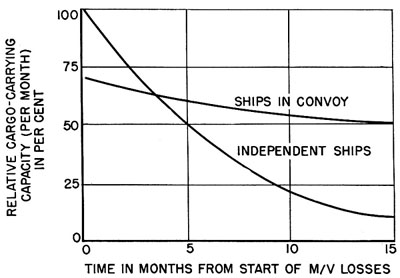 |
FIGURE 9. Cargo carrying capacity of ships during submarine offensive. |
In deciding on the desirability of convoying, however, the total cargo carried is the chief item of interest. After 3 months the independent ships would still
have carried more cargo because they had a considerable initial advantage. It would not be until after about 6 or 7 months that the convoyed ships would have the
larger total. This total is plotted in Figure 10.
Thus the overall value of convoying in any particular situation depends on how much longer the war is going to last, among all other things. For the
conditions represented by Figure 10, independent ships would produce the best result as long as the war was not likely to last more than 7 months,
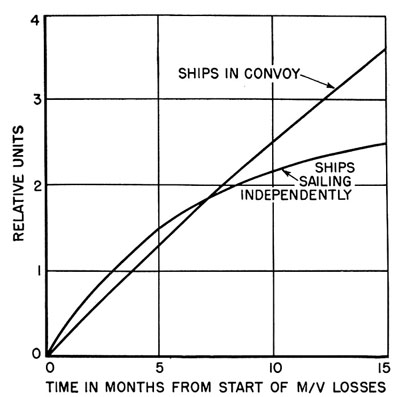 |
FIGURE 10. Total cargo carried. |
--111--
whereas convoying would be desirable in a longer war. In addition, the bad effects of failing to convoy in the latter case appear somewhat more serious
than the bad effects of convoying when one should not do so, which may be reason for advocating a generally conservative procedure. The overall conclusion is,
then, that convoying is a powerful method for protecting ships, but that it should not be applied unless the seriousness of the enemy's submarine offensive and
the probable duration of the war justify it. If the danger from submarines is fairly great, then large convoys should be formed.
--112--
Table of Contents
Previous Chapter (9) * Next Chapter (11)
Footnotes
Transcribed and formatted for HTML by Rick Pitz for the HyperWar Foundation














